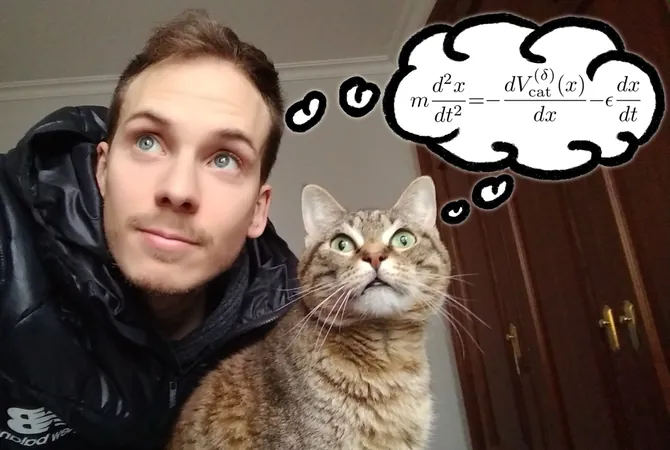
Meet the Purr-fect Equation: How One Physicist and His Cat Are Revolutionizing Classical Mechanics
2024-11-04
Author: Rajesh
In the age of social media, cats have undoubtedly captured the hearts of millions, often becoming the reigning champions of our digital landscape. However, these furry feline friends have also found their way into the realm of science, thanks to the genius of physicist Anxo Biasi. Inspired by his cat Eme, Biasi set out to capture the essence of feline movement in a groundbreaking paper published in the American Journal of Physics.
The Equation of Cat Motion: A Playful Insight into Physics
Anxo's initiative to publish this unique article serves not just to satisfy scientific curiosity but to make physics accessible and enjoyable for everyone. He explains, "This article aims to bridge the gap between physics and non-experts, using a relatable example of cat behavior to illuminate concepts of classical mechanics." By treating Eme as a point particle moving in a field affected by human presence, Biasi constructed an equation that models a cat's behavior in various situations.
The Journey from a Playful Thought to Academic Achievement
Anxo joined the Instituto Galego de Física de Altas Enerxías (IGFAE) in Spain as part of La Caixa's Junior Leader program after completing his doctoral thesis in Paris. While working at IGFAE—which collaborates with the University of Santiago de Compostela—he is now diving deep into non-linear evolution equations, blending his knowledge of physics and mathematics.
Though the research began as a tongue-in-cheek project for April Fool's Day, it blossomed into something that could genuinely aid physics students in their learning journey. Anxo noted, "I soon realized that what started as a fun concept could have significant educational value."
Crafting the Cat Motion Equation
Using everyday observations of Eme's behaviors, Anxo derived seven dynamics that capture a cat's interaction with humans. The hypothesis that "cats perceive a force around their owners" served as the foundation for modeling their movements. The key variables include the mix of the cat's mass, fatigue from friction, and the external influences of their human companions. This led to the crafting of an equation that not only elucidates feline locomotion but also engages students with relatable and amusing examples.
From Purring to Zoomies: A Comprehensive Analysis
Anxo's paper doesn't stop at basic movements. He explores the stable dynamics of a cat's purring—interpreting it as a feedback loop reinforced through affectionate interaction with humans. The joy of mutual affection creates a stable environment for both the cat and its human.
The paper also takes a closer look at the curious phenomenon known as "zoomies," the moments when cats dash around with uncontrolled excitement, often during the night. Anxo introduced a random variable to his equation to accurately reflect these unpredictable bursts of energy. Each cat's particularities may also influence these zoomie moments, adding a personal touch to the model.
Educational Value and Broader Implications
With a broader vision, Anxo aims for his findings to serve as a useful educational tool in introductory physics courses. By demonstrating that intricate cat behaviors can be described by simplified principles of classical mechanics, he hopes to inspire future scientists. "We don’t always have to tackle the grandest mysteries of the universe," he asserts, "Sometimes, you can find joy—and valuable lessons—in the simple things, like the antics of a cat."
In Conclusion: A Unique Intersection of Physics and Everyday Life
Anxo Biasi's innovative approach merges the worlds of science and everyday life, emphasizing that physics can be relatable and fun. As more researchers look to bridge the gap between complex scientific principles and accessible learning, we can anticipate a purr-fect blend of entertainment and education that keeps us engaged—one cat at a time!




 Brasil (PT)
Brasil (PT)
 Canada (EN)
Canada (EN)
 Chile (ES)
Chile (ES)
 Česko (CS)
Česko (CS)
 대한민국 (KO)
대한민국 (KO)
 España (ES)
España (ES)
 France (FR)
France (FR)
 Hong Kong (EN)
Hong Kong (EN)
 Italia (IT)
Italia (IT)
 日本 (JA)
日本 (JA)
 Magyarország (HU)
Magyarország (HU)
 Norge (NO)
Norge (NO)
 Polska (PL)
Polska (PL)
 Schweiz (DE)
Schweiz (DE)
 Singapore (EN)
Singapore (EN)
 Sverige (SV)
Sverige (SV)
 Suomi (FI)
Suomi (FI)
 Türkiye (TR)
Türkiye (TR)
 الإمارات العربية المتحدة (AR)
الإمارات العربية المتحدة (AR)